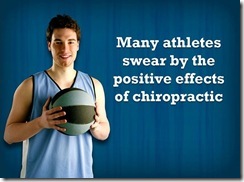What You Should Know About Concussions
The Center for Disease Control and Prevention reports 1.7 million people sustain a traumatic brain injury (TBI) each year, and the majority of these cases are classified as concussions (also know as mild traumatic brain injury)
![image_thumb[1] (13)](https://prioritylifechiro.com/wp-content/uploads/2015/12/image_thumb1-13.png)
This health problem has risen in the public eye in the last year – the result of several professional athletes being affected by concussions. Recent research suggests we may be underestimating the impact of mild brain trauma on long-term neurological health.
A study published in the medical journal Brain indicates athletes who sustained concussions in early adulthood showed evidence of mental and physical deterioration 30 years after the event.
Impact to the head can cause the brain to move inside the skull, which can lead to bruising, blood vessel damage, swelling and bleeding – sometimes severe enough to require immediate medical intervention to prevent serious brain damage or death.
Sport concussions grab most of the media attention, but this type of brain injury can result from car accidents, workplace incidents, falls and fights.
To get familiar with concussions, here are the most common symptoms
• Headache
• Slurred speech
• Confusion
• Blurred vision
• Dizziness
• Light and noise sensitivity
• Nausea and vomiting
• Memory and concentration problems
If an injured person has symptoms that last beyond 15 minutes or loses consciousness, he or she should be evaluated by a physician.
Concussions: Get Serious!
Health researchers are pointing to evidence that reveals the public may not be taking concussions as seriously
as it should.
About half a million children visit hospital emergency departments annually for treatment of traumatic brain injury. The medical journal Pediatrics published a study that showed hospitalized children who were labeled as having a concussion spent fewer days in the hospital compared to children who were labeled as having mild traumatic brain injury – even though the labels mean the same thing.3 Another troubling statistic revealed high school football players were more likely to suffer concussions and severe head injuries compared to college
players. The American Journal of Sports Medicine published this
evidence, noting there were 0.67 injuries per 100,000 players at the high school level but only 0.21 per 100,000 players at the college level.4 One of the study authors suggested a possible reason could be that high schools do not usually have team physicians, unlike at the college level. This may result in improper
diagnosis and players returning to the field before they have adequately recovered from their injury.
![image_thumb[2] (9)](https://prioritylifechiro.com/wp-content/uploads/2015/12/image_thumb2-9.png)
Football is not the only sport where concussions occur. An analysis of minor league hockey in Canada indicated there was a significant increase in head injuries, including concussions, among nine and ten year old players when hockey organizations
allowed body checking for this age group. In December of last year, the Radiological Society of North America presented interesting research on soccer players and brain trauma. The study looked at 38 amateur players who frequently hit the soccer ball (several times daily) with their head. They scored 20% lower in verbal memory and processing speed compared to players who rarely hit the ball with their head. Brain imaging scans of the
38 players revealed microscopic white matter, consistent with traumatic brain injury.
![image_thumb[4] (2)](https://prioritylifechiro.com/wp-content/uploads/2015/12/image_thumb4-2.png)
Currently, many athletes participate in baseline concussion tests that measure cognitive performance involving memory, concentration and reaction time. If an athlete suffers a suspected
concussion, he retakes the test to see if any changes have occurred since the injury. However, health researchers at at Loyola University uncovered the possibility of high false negative tests, which could mean an athlete returns to
play prematurely.
Concussions and Chiropractic
One of the highest profile sport concussions cases is that of NHL superstar Sidney Crosby. After suffering concussions, Crosby had to endure an extensive break from playing hockey to rest and recuperate. While he was sidelined, Crosby received treatment from a team of chiropractic
neurologists. The therapy consisted of non-invasive, drug free rehabilitation that included adjustments and receptor-based stimulation of the senses, exercise and dietary changes to boost the function of the brain and nervous system.8 The treatment has helped many concussion sufferers to heal and recover more quickly from injury.
Your chiropractor wants you to take precautions to avoid concussions.
While engaged in sports, use proper equipment. Always wear a seatbelt when in a vehicle and familiarize yourself with the symptoms of a concussion. If you have any questions, talk to your chiropractor.
![image_thumb[7] (1)](https://prioritylifechiro.com/wp-content/uploads/2015/12/image_thumb7-1.png)

![image_thumb[4] (4)](https://prioritylifechiro.com/wp-content/uploads/2015/12/image_thumb4-4.png)
![image_thumb[5] (1)](https://prioritylifechiro.com/wp-content/uploads/2015/12/image_thumb5-1.png)
![image_thumb[6] (1)](https://prioritylifechiro.com/wp-content/uploads/2015/12/image_thumb6-1.png)
![image_thumb[7] (2)](https://prioritylifechiro.com/wp-content/uploads/2015/12/image_thumb7-2.png)


![clip_image002[4]_thumb](https://prioritylifechiro.com/wp-content/uploads/2015/12/clip_image0024_thumb.gif)
![clip_image002[6]_thumb](https://prioritylifechiro.com/wp-content/uploads/2015/12/clip_image0026_thumb.gif)
![image_thumb[3] (4)](https://prioritylifechiro.com/wp-content/uploads/2015/12/image_thumb3-4.png)
![image_thumb[2] (11)](https://prioritylifechiro.com/wp-content/uploads/2015/12/image_thumb2-11.png)


![image_thumb[1] (17)](https://prioritylifechiro.com/wp-content/uploads/2015/12/image_thumb1-17.png)
![clip_image002_thumb[1]](https://prioritylifechiro.com/wp-content/uploads/2015/12/clip_image002_thumb1.gif)
![clip_image002[5]_thumb](https://prioritylifechiro.com/wp-content/uploads/2015/12/clip_image0025_thumb.gif)
![319606_10150394834838052_155474938051_8527542_1939092632_n_thumb[2]](https://prioritylifechiro.com/wp-content/uploads/2015/12/319606_10150394834838052_155474938051_8527542_1939092632_n_thumb2.jpg)


![clip_image002[5]_thumb[1]](https://prioritylifechiro.com/wp-content/uploads/2015/12/clip_image0025_thumb1.gif)
![clip_image002_thumb[1] (1)](https://prioritylifechiro.com/wp-content/uploads/2015/12/clip_image002_thumb1-1.gif)
![clip_image002[7]_thumb[1]](https://prioritylifechiro.com/wp-content/uploads/2015/12/clip_image0027_thumb1.gif)